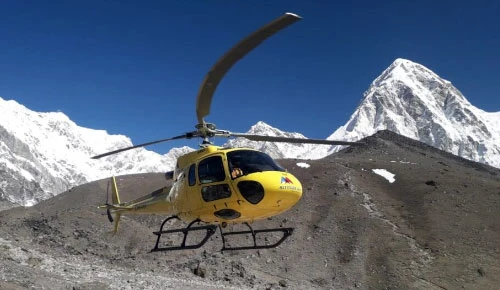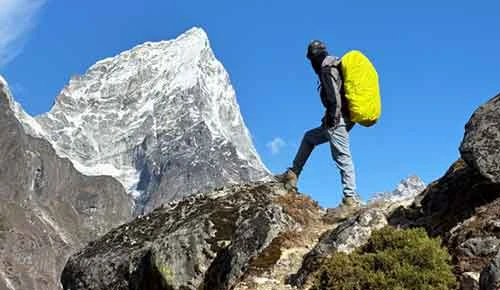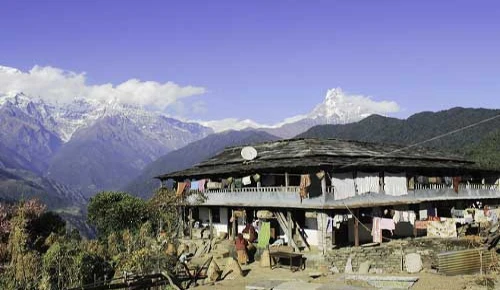Best Places for Snowfall in Nepal
Nepal is a country known for its natural beauty and diverse landscapes. From lush tropical forests to snow-capped mountains, there is something for everyone in Nepal. If you're looking to experience the winter wonderland of the Himalayas, the best time to see snowfall in Nepal is typically between December and February.
The Himalayas, the highest mountain range in the world, run through Nepal, and it is home to eight of the ten highest peaks in the world, including Mount Everest. The snow-capped peaks of the Himalayas are a sight to behold and trekking to see them is an experience of a lifetime. However, the best time to see snowfall in Nepal depends on a few factors, including the location and the weather patterns.
Table of Contents
Nepal is a country known for its natural beauty and diverse landscapes. From lush tropical forests to snow-capped mountains, there is something for everyone in Nepal. If you're looking to experience the winter wonderland of the Himalayas, the best time to see snowfall in Nepal is typically between December and February.
The Himalayas, the highest mountain range in the world, run through Nepal, and it is home to eight of the ten highest peaks in the world, including Mount Everest. The snow-capped peaks of the Himalayas are a sight to behold and trekking to see them is an experience of a lifetime. However, the best time to see snowfall in Nepal depends on a few factors, including the location and the weather patterns.
Snowfall places in Nepal
Nepal is home to the Himalayas, which means that there are many places in the country where you can see snowfall. Some of the most popular places in Nepal to see snowfall include:
Kathmandu
Kathmandu, the capital of Nepal, occasionally receives snowfall, but it is not a regular occurrence.
Pokhara
The city of Pokhara is located at a lower altitude than Kathmandu and is less likely to receive snowfall.
Langtang
Langtang is a trekking area located north of Kathmandu and is known for its beautiful mountain views and snowfall.
Annapurna
The Annapurna region is popular for trekking and receives heavy snowfall during the winter months.
Dhaulagiri
Dhaulagiri is a mountain in the western part of Nepal and is the seventh highest peak in the world. The Dhaulagiri trek is also a popular destination for trekkers, and it gets heavy snowfall during the winter months.
Everest Base Camp
The trek to Everest Base Camp is one of the most popular treks in Nepal and gets heavy snowfall in the winter months.
Mustang
Mustang is a remote region in the north-central part of Nepal and is known for its snow-capped mountains and ancient culture.
Manang
Manang is a popular trekking destination located in the Annapurna region, and it is known for its beautiful mountain views and snowfall.
It's worth noting that the best time to see snowfall in Nepal is typically between December and February, although the exact timing can vary from year to year. Additionally, it's important to note that trekking in the snow can be dangerous and it's important to be prepared with the proper gear and to hire a guide if you are not experienced in trekking in snowy conditions.
List of places near Kathmandu valley that are known to receive snowfall
Snowfall is relatively rare around Kathmandu, Nepal, as the city is located at an elevation of about 1,400 meters (4,600 feet) and has a subtropical climate. The average temperature in Kathmandu is around 15°C (59°F) in winter and around 25°C (77°F) in summer. Snowfall typically occurs in the higher elevations surrounding Kathmandu, such as the Himalayan mountain ranges. Places like Nagarkot, Daman, and other hill stations around Kathmandu can be good destinations for snowfall viewing during winter. However, it is important to note that snowfall in Nepal is unpredictable, and it can occur at any time of the year, but it is not a common phenomenon around Kathmandu.
Here is a list of places near Kathmandu valley that are known to receive snowfall:
Kalinchowk
Kalinchowk is a popular tourist destination in Nepal, known for its beautiful views of the Himalayas and its temple dedicated to the goddess Kali. The area also receives heavy snowfall during the winter months, making it a popular destination for skiing and other winter sports. The Kalinchowk temple, situated at an altitude of 3,800 meters, is covered in snow during winter months.

Many visitors come to Kalinchowk to see the snow-covered temple and enjoy the winter sports. The snowfall starts around November and continues till March, making it a perfect destination for winter sports enthusiasts and people who love the snow. Visitors can also enjoy other activities such as trekking and hiking in the snow-covered mountains.
Chandragiri
Chandragiri is a hill located in the Kathmandu valley of Nepal, known for its beautiful views of the Himalayas and its cable car ride that takes visitors to the top of the hill. The area also receives snowfall during the winter months, making it a popular destination for skiing and other winter sports. Chandragiri Hills is a popular destination for tourists and locals alike. The cable car ride provides visitors with panoramic views of the Kathmandu valley, and the summit offers a beautiful view of the Himalayas.

The snowfall starts around December and continues till February, making it a perfect destination for winter sports enthusiasts and people who love the snow. Visitors can also enjoy other activities such as trekking and hiking in the snow-covered mountains.
Nagarkot
Nagarkot is a hill station located in the Bhaktapur district of Nepal, known for its beautiful views of the Himalayas, particularly Mount Everest. A hill station located about 32 km east of Kathmandu, known for its panoramic views of the Himalayas and snowfall during winter. The area typically receives snowfall during the winter months, with the peak snowfall occurring between December and February.

Nagarkot is a popular destination for tourists and locals alike, and during the winter, it is known for its snow-covered landscapes and clear views of the Himalayas. Visitors can enjoy skiing, snowboarding and other winter sports, as well as trekking and hiking in the snow-covered mountains. The snowfall in Nagarkot is heavy and long-lasting, making it a great spot to enjoy a winter holiday in Nepal.
Daman
A hill station located about 80 km southwest of Kathmandu, known for its panoramic views of the Himalayas, including Mount Everest, and snowfall during winter.
Helambu
A valley located about 80 km northeast of Kathmandu, known for its traditional Sherpa villages, scenic trekking routes, and snowfall during winter.
Langtang
A valley located about 75 km north of Kathmandu, known for its trekking routes, and snowfall during winter.
Gosainkunda
A high altitude lake located about 130 km north of Kathmandu, known for its religious significance, trekking routes, and snowfall during winter.
Jugal Himal
A mountain range located about 150 km northwest of Kathmandu, known for its trekking routes and snowfall during winter.
Melamchi
A hill station located about 80 km east of Kathmandu, known for its trekking routes, and snowfall during winter.
Please note that these places are known to receive snowfall but the amount of snowfall and duration can vary depending on the weather conditions. It is always best to check the current weather conditions and the forecast before planning a trip to these places during winter.
List of places near Pokhara valley that are known to receive snowfall
Pokhara is located at an elevation of about 800 meters (2,600 feet) and has a subtropical climate, so snowfall is relatively rare in the city itself. However, there are some places in the surrounding areas that are known to receive snowfall:
Sarangkot
A hill station located about 15 km northwest of Pokhara, known for its panoramic views of the Himalayas, including Annapurna and Dhaulagiri, and occasional snowfall during winter.
Kaskikot
A hill station located about 25 km northwest of Pokhara, known for its panoramic views of the Himalayas and occasional snowfall during winter.
Poon Hill
A hill station located about 32 km northwest of Pokhara, known for its panoramic views of the Himalayas, including Annapurna, Dhaulagiri, and Machhapuchhre, and occasional snowfall during winter.
Ghorepani
A hill station located about 32 km northwest of Pokhara, known for its panoramic views of the Himalayas and occasional snowfall during winter.
Mardi Himal
A mountain located about 40 km southeast of Pokhara, known for its trekking routes and occasional snowfall during winter.
Annapurna Base Camp
A mountain base camp located about 130 km northwest of Pokhara, known for its trekking routes and occasional snowfall during winter.
List of additional places in Nepal that are known to receive snowfall
Here is a list of additional places in Nepal that are known to receive snowfall:
Everest Base Camp
A mountain base camp located in the Solukhumbu district, known for its trekking routes and snowfall during winter. Everest base camp trek takes you to the base camp of the world's highest mountain, Mount Everest.

The trek passes through the Sagarmatha National Park, a UNESCO World Heritage Site, and offers stunning views of the Himalayas. The trail is strenuous and reaches elevations of up to 5,364 meters (17,598 feet) where snowfall is common during the winter months.
Thorong La Pass

A high altitude pass located in the Annapurna region, known for its trekking routes and snowfall during winter. The Thorong La Pass is a high-altitude pass located in the Annapurna region. The trek to the pass offers spectacular views of the Himalayas and passes through traditional villages, lush forests, and high-altitude deserts. The pass is located at an elevation of 5,416 meters (17,769 feet) and snowfall is common during the winter months.
Dhaulagiri Base Camp

A mountain base camp located in the Myagdi district, known for its trekking routes and snowfall during winter. Dhaulagiri Base Camp trek is one of the most strenuous trek in Nepal, but the views of Mt. Dhaulagiri, the 7th highest peak in the world, and other peaks are truly worth it. The trek takes you to the base camp of Dhaulagiri at an elevation of 4,750 meters (15,584 feet) where snowfall is common during the winter months.
Manaslu Base Camp

A mountain base camp located in the Gorkha district, known for its trekking routes and snowfall during winter. Manaslu Base Camp trek takes you to the base camp of the eighth highest peak in the world, Mount Manaslu. The trek passes through traditional villages, lush forests, and high-altitude deserts. The base camp is located at an elevation of 4,500 meters (14,764 feet) and snowfall is common during the winter months.
Tsum Valley

A remote valley located in the Gorkha district, known for its trekking routes and snowfall during winter. Tsum Valley is a remote valley located in the Gorkha district, known for its traditional Tibetan villages, monasteries, and stunning views of the Himalayas. The valley is located at an elevation of 3,700 meters (12,139 feet) and snowfall is common during the winter months.
Rara Lake

A high altitude lake located in the Mugu district, known for its trekking routes and snowfall during winter. Rara Lake is a high-altitude lake located in the Mugu district and is the largest lake in Nepal. The trek to the lake passes through traditional villages, lush forests, and high-altitude deserts. The lake is located at an elevation of 2,990 meters (9,810 feet) and snowfall is common during the winter months.
Kanchenjunga Base Camp

A mountain base camp located in the Taplejung district, known for its trekking routes and snowfall during winter. Kanchenjunga Base Camp trek offers a chance to explore one of the most remote and unspoiled regions of Nepal. The trek takes you to the base camp of the third highest mountain in the world, Mount Kanchenjunga. The base camp is located at an elevation of 4,800 meters (15,748 feet) and snowfall is common during the winter months.
Mustang

A remote region located in the Mustang district, known for its trekking routes and snowfall during winter. Mustang is a remote region located in the Mustang district, known for its traditional Tibetan villages, monasteries, and stunning views of the Himalayas. The region is located at an elevation of 3,800 meters (12,467 feet) and snowfall is common during the winter months.
Please note that these places are known to receive snowfall but the amount of snowfall and duration can vary depending on the weather conditions. It is always best to check the current weather conditions and the forecast before planning a trip to these places during winter.
Guide to Travelling in Snowfall in Nepal: Tips and Tricks for a Safe and Enjoyable Trip
Nepal is a beautiful country that offers a wide variety of options for those looking to experience snowfall. However, traveling during the winter can be challenging, so it's important to be prepared. Here is a guide to help you plan your trip:
Check the weather forecast
Before planning your trip, be sure to check the weather forecast for the area you plan to visit. This will give you an idea of what to expect and help you plan accordingly.
Pack the right clothes
Dress in layers and pack warm clothing, including a jacket, gloves, a hat, and thermal underwear. Make sure you also pack sturdy boots and waterproof gear. Backpack Checklist for travelling in nepal.
Be aware of altitude sickness
Snowfall destinations in Nepal are often located at high elevations, which can cause altitude sickness. Be aware of the symptoms and take precautions, such as acclimatizing properly and consulting with a doctor if you have any concerns.
Hire a guide
If you're planning to trek to a snowfall destination, it's a good idea to hire a guide who is familiar with the area. They can help you navigate the terrain and ensure your safety.
Plan for transportation
Some snowfall destinations can be difficult to reach by car or bus, so it's important to plan for transportation in advance. Consider hiring a jeep or hiring a helicopter if necessary.
Don't forget travel insurance
It's essential to have travel insurance when visiting a place with snowfall. Make sure your insurance covers emergency medical expenses, trip cancellation, and other travel-related risks.
Be flexible:
Keep in mind that weather conditions in Nepal can be unpredictable, so be prepared to change your plans if necessary. Make sure to have backup options in case your original plan doesn't work out.
By following these guidelines, you can make the most of your trip to Nepal and enjoy the beautiful snowfall the country has to offer.
Best Time to See Snowfall in Nepal
The best time to see snowfall in the higher elevations of Nepal, such as the Himalayas, is typically between December and February. During these months, the temperatures are at their coldest and the chance of snowfall is highest. This is the peak winter season in Nepal, and trekking routes that take you to higher elevations, such as the Everest Base Camp TrekEverest base camp short trek and the Annapurna Circuit Trek, are likely to have snowfall.
However, it's worth noting that the timing of snowfall can vary from year to year, and it is affected by the weather patterns. For example, if there is an El Nino year, the snowfall can be less than expected. Additionally, the amount of snowfall can also vary depending on the location. For example, areas at higher elevations such as the Himalayas are more likely to receive heavy snowfall than areas at lower elevations such as Kathmandu.
Even though Kathmandu is located at an elevation of 1,400 meters and is not known for snowfall, it occasionally receives snowfall, but it is not a regular occurrence. On the other hand, Pokhara, which is located at an elevation of 827 meters, is less likely to receive snowfall, but it can happen.
Another important factor to consider is the monsoon season, which typically runs from June to September. During this time, trekking routes are closed due to heavy rainfall and landslides. So, it's important to plan accordingly and check the latest information before planning a trek.
Trekking to see snowfall in Nepal is a popular activity and offers an experience of a lifetime. However, it's important to be prepared for the cold temperatures and snowy conditions. It's recommended to have proper gear such as warm clothing, insulated boots, and a good quality sleeping bag to ensure that you're comfortable and safe during your trek.
It's also important to hire a guide if you're not experienced in trekking in snowy conditions, as trekking in the snow can be dangerous. Guides are knowledgeable about the trekking routes and are trained to handle emergencies. Additionally, they can help you with the permits and other paperwork required for the trek.
In conclusion, the best time to see snowfall in Nepal is typically between December and February. However, the timing of snowfall can vary from year to year and is affected by the weather patterns. Additionally, the amount of snowfall can also vary depending on the location. It's important to plan accordingly, check the latest information, and be prepared for the cold temperatures and snowy conditions. Additionally, it's important to hire a guide if you're not experienced in trekking in snowy conditions. With the right preparation and mindset, you're sure to have an unforgettable experience trekking in the snow-capped peaks of the Himalayas in Nepal.








